
From the many kinds of mōlli (simply meaning “sauce”, in Nahuatl language) that were ground in pre-Hispanic metates (stone grinders), to the Baroque recipes developed during colonial times in convents and homes around Puebla, Oaxaca and Mexico City, today’s mole rojo (red mole) is identified as a National dish in Mexico and recognized as the most representative mole around the world. I love moles, red or otherwise, and while living in Mexico, I had the opportunity to try not only the famous mole poblano (Puebla style red mole), but other equally delicious concoctions, such as green, yellow, or black moles, and more contemporary variations, such as mole with tamarind. As a grown up, I also occasionally bought different kinds of mole paste from a picturesque market in San Angel, a quaint neighbourhood in Mexico City, or from the now traditional mole festival in San Pedro Atocpan, established in 1978 to magnify the already well recognized reputation of the region for its delicious moles.
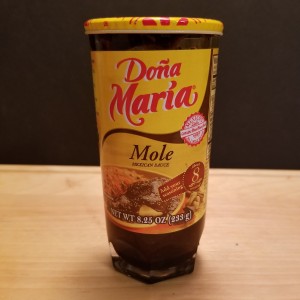 However, I have a confession to make: I grew up eating mostly mass-produced red mole (yes, out of that slim glass container that every Mexican knows, seen in the photo); I enjoyed it with chicken, in Lent and Christmas dishes, and in homemade enchiladas and tamales. Needless to say, after moving to Canada, that practice was perpetuated by pure lack of choices, and I have even kept the empty containers, to use as vases for my fresh cut herbs and such (they fit nicely in the fridge-door shelf). In all honesty, Doña María™ original mole is a good example of red mole, and the brand I still buy and recommend to friends here in Canada.
However, I have a confession to make: I grew up eating mostly mass-produced red mole (yes, out of that slim glass container that every Mexican knows, seen in the photo); I enjoyed it with chicken, in Lent and Christmas dishes, and in homemade enchiladas and tamales. Needless to say, after moving to Canada, that practice was perpetuated by pure lack of choices, and I have even kept the empty containers, to use as vases for my fresh cut herbs and such (they fit nicely in the fridge-door shelf). In all honesty, Doña María™ original mole is a good example of red mole, and the brand I still buy and recommend to friends here in Canada.
However, there is a point – I think – in every Mexican cook’s life, when she/he feels the urge to make red mole from scratch, playing with ingredients and techniques, transforming the kitchen into a laboratory. Although there are red mole recipes from several Mexican states, and Doña María™ mole started with the family recipe of a lady with the same name from the Mexican state of San Luis Potosí, I decided to start by reviewing the recipe from the Convento de Santa Rosa de Lima, in Puebla, since it is recognized by many (still disputed by others) that the first red mole was created to dress a turkey, to serve to a noble figure during a visit to the convent in the XVII century; they even have a museum, dedicated to this origin story.
For moles in general, there are a few basic groups of ingredients, and each recipe will call for some in particular, depending on the flavours, colours and textures that are needed: peppers (fresh or dry, red, green or other); seeds and nuts (sesame, squash, peanuts, almonds, etc.); fruits (again fresh or dry); thickeners (tortilla, bread, crackers); seasonings (salt, sugar, spices and other aromatics); liquids (broth, water); fat (lard or other); and in special cases, such as for red mole, chocolate.
My recipe includes most of the ingredients from the Santa Rosa recipe, and I added a different angle from information in the recipe of “Mole poblano de guajolote” (“Turkey in Puebla Style Mole”) which I found in “El Libro de la Cocina Mexicana” by Susanna Palazuelos et al. I omitted tomatoes and turkey broth, to make it less perishable and keep it vegetarian, and changed quantities, or added ingredients, to create my own version. In my printable recipe below, I documented the ingredients, quantities and procedures that I used for the batch being prepared for this post, including suggestions for alternatives, depending on personal taste or availability of ingredients.
Homemade Red Mole – Mole rojo hecho en casa
Printable recipe: Homemade Red Mole
Ingredients
Peppers:
9 dry red peppers (ancho, mulato, pasilla, cascabel, guajillo, New Mexico)
2 dry hot peppers (dry chipotle, morita, de árbol or omit)
Seeds and Nuts:
¼ cup sesame seed; dry toasted
¼ cup peeled peanuts (with or without red film)
¼ cup almonds, or other nuts (hazelnuts, pine nuts)
Fruits:
1 plantain, very ripe
¼ cup raisins
¼ cup prunes (optional)
Thickeners:
½ cup animal crackers (or soda, Maria, or stale bread)
½ corn tortilla (optional)
Seasonings:
¼ tsp anise seed
¼ tsp ground cinnamon (or a piece of Mexican cinnamon stick)
¼ tsp ground cloves (or 2-3 whole)
4 cloves garlic
Salt, to taste
Liquid:
1 cup water or broth, or more, as needed; hot
Fat:
4 tbsp vegetable oil or lard
More lard or vegetable oil, as needed
Chocolate:
4 oz (112 g) Mexican chocolate (Ibarra, Abuelita) OR
2 oz (56 g) unsweetened baking chocolate and ¼ cup raw sugar (see *Note below)
Peppers: The traditional ratio of peppers in mole poblano is around 4 mulato/3 ancho/2 pasilla. I could not find mulato peppers, so I used 4 cascabel instead, and added an extra pasilla, for colour depth. In the photo below, from left to right, 3 pasilla, 3 ancho and 4 cascabel peppers:
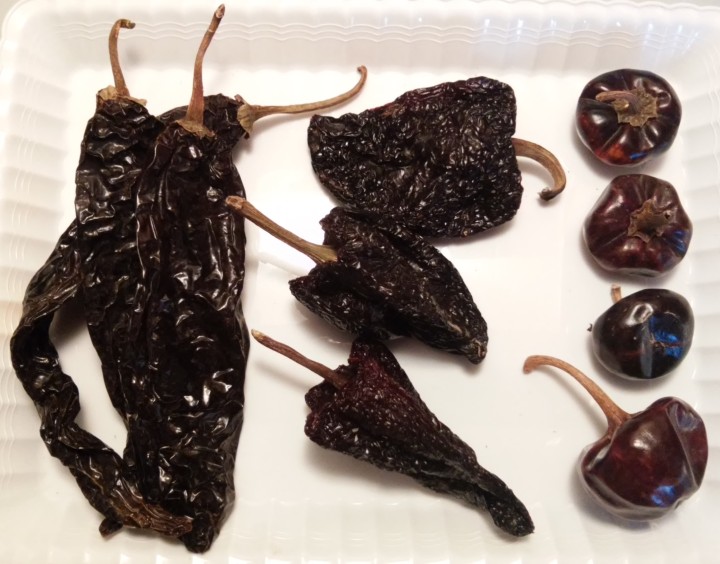
Note: Both mulato and ancho peppers are dried poblano peppers, but anchos are obtained by drying ripe poblanos that have turned red in colour. Mulatos come from special varieties which are very dark in colour, grown for the sole purpose of producing mulato peppers; they are dried from dark green stages, to dark brown, like chocolate. When set next to each other, anchos and mulatos may look similar, but when opened and inspected against light, anchos are reddish and mulatos look very dark brown, almost black. Their flavour profiles are different as well and, together with the pasilla, form the traditional trinity of peppers for red moles. Instead of adding cascabel, using equal amounts of pasilla and ancho is another possibility.
These peppers are mild to medium hot; 2 dry hot peppers may be added for a spicier taste; I did not use any.
Remove stems and seeds from the peppers, and reserve:
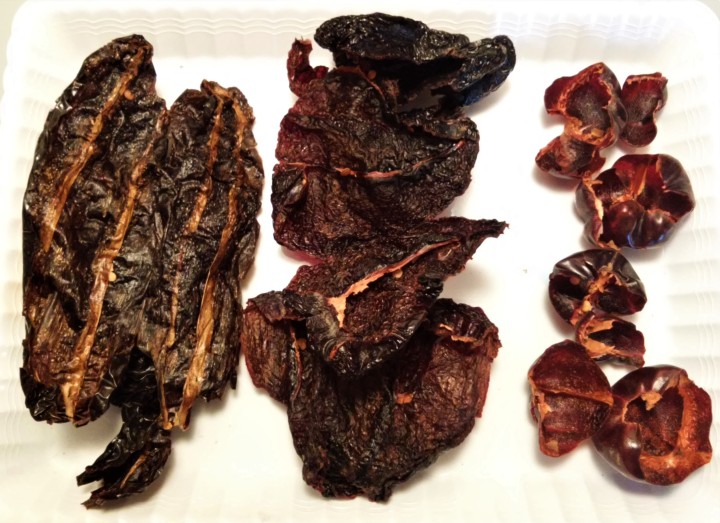
Seeds and nuts: Sesame seeds and peanuts are the staple, and other nuts like almonds, hazelnuts and pine nuts may be added. I chose equal volumes of roasted sesame seed, peeled and chopped almonds, and peeled peanuts:
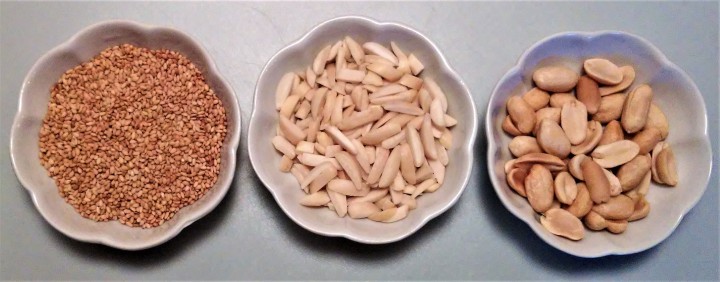
Note: I found roasted sesame seed in an Asian market, but if it is raw, toast the seeds in a dry pan (no oil) over medium heat until they change colour and a few seeds start to pop; do not overcook. The almonds may also be used whole, and the peanuts left with their red film intact.
Fruits and thickeners: The plantain must be as ripe as possible (the peel is completely black in this case, photo below). Raisins are always included. Some of the old recipes used fresh plums, but nowadays, most recipes omit them or call for prunes; I did not use them. The plantain is also a thickener, and I stuck to animal crackers from the original recipes (stale bread or soda crackers could be other options). Some recipes use corn tortillas in addition to the bread; I omitted, but this could be a nice alternative for people with gluten intolerance. In the photo below, very ripe plantain, raisins and animal crackers:
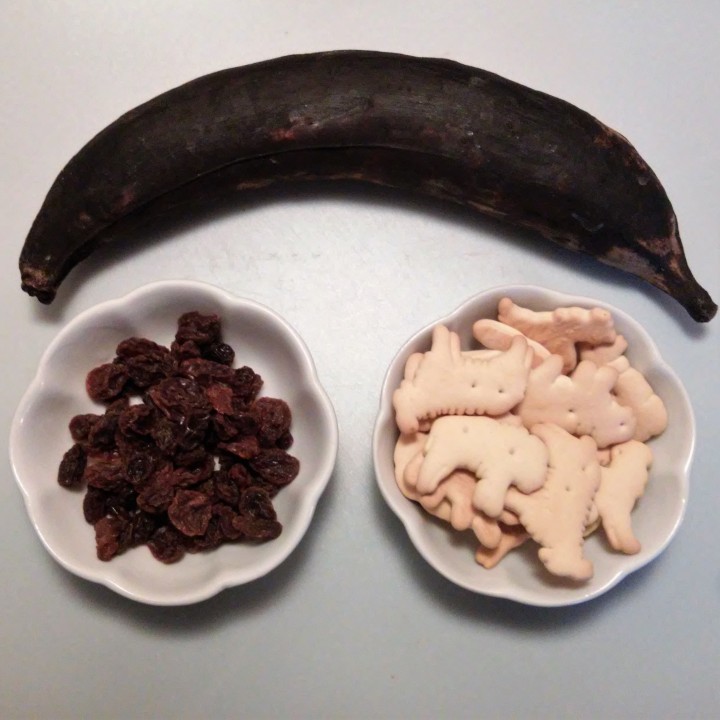
Peel and slice plantain, and reserve, along with the raisins and crackers:
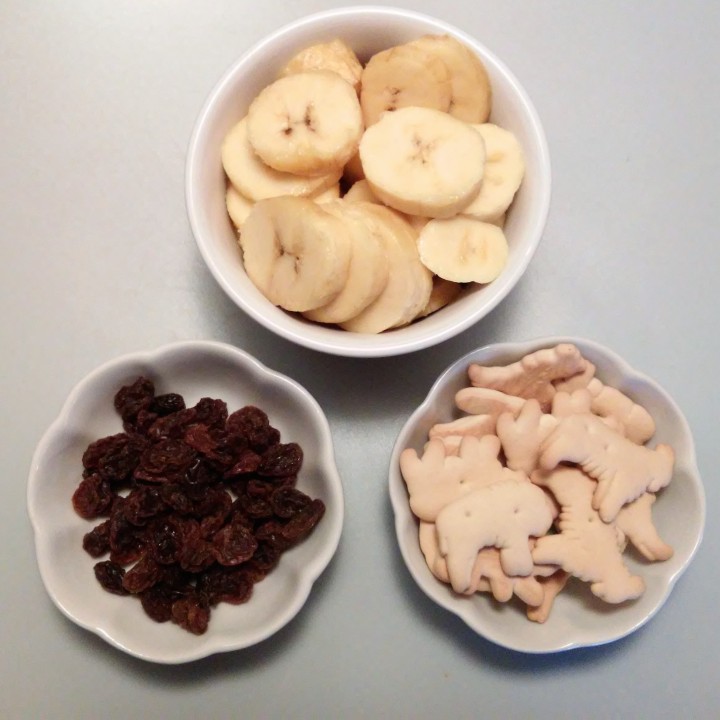
Seasonings: I personally do not like caraway and anise flavours in general, but anise seeds are an essential part of every single recipe of red mole I have seen, so there it is, I included a whole 1/4 tsp, along with cloves and Mexican cinnamon; fresh garlic and salt complete the seasonings (photo below, left). Peel and slice garlic; grind spices with a mortar and pestle, or in an electric grinder; reserve (photo right):
Important note: do not attempt to grind cinnamon sticks unless they are the bark-like Mexican kind (pictured above); hard cinnamon sticks will be most likely impossible to grind, and could even damage an electric grinder. For better accuracy, measure spices after grinding. As an alternative, use already ground spices.
Liquid and fat: traditional recipes use turkey broth and lard, but as mentioned, I wanted to make my mole less perishable and keep it vegetarian, so I used water and vegetable oil.
Chocolate: last, but definitely not least, in fact the star ingredient of red mole, chocolate should preferably be in the form of Mexican tablets for hot chocolate, which I have mentioned before (some brands are Ibarra™, Abuelita™ and Mayordomo™). I used Ibarra tablets:
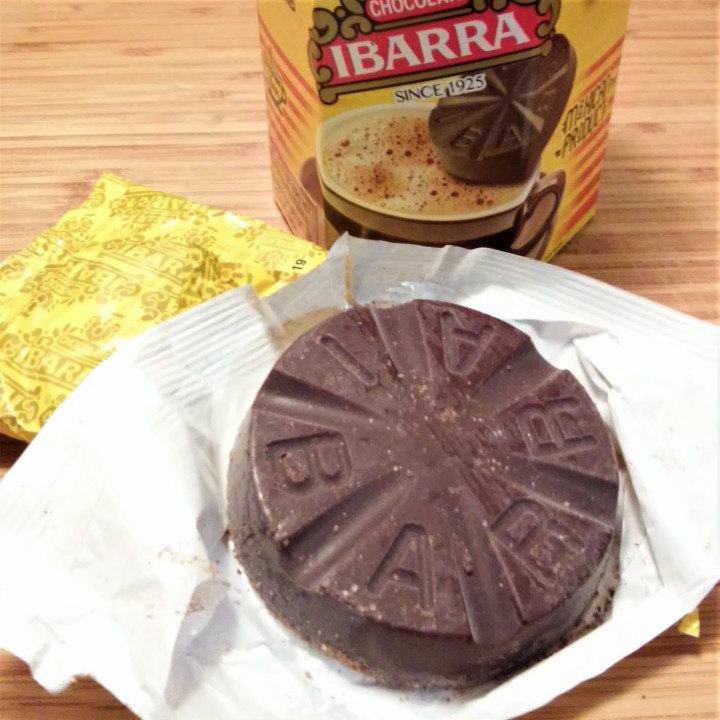
*Note: Mexican tablets already contain sugar and often, cinnamon; if it is not possible to find them, I would substitute by using unsweetened chocolate for baking, adding raw sugar and increasing the amount of cinnamon in the recipe by just a pinch. For this recipe, the equivalent of 4 oz. of Mexican chocolate would be 2 oz. of unsweetened chocolate and 1/4 cup of raw sugar:

Gathering and prepping the ingredients is half the work. The rest of the recipe consists of frying and/or grinding all these ingredients. First, grind the roasted sesame seeds, either with a spice grinder or with a mortar and pestle; if not possible, just leave them whole. Place in a large bowl or plate, along with the ground spices:

In a frying pan, warm up 4 tablespoons of oil (or lard) over medium heat. The nuts, garlic, fruits, thickeners and peppers will be fried in this pan, one by one, in that order, then placed in the bowl. Start with the almonds, stirring until golden brown; continue with the peanuts (photo below, left). After the nuts, fry the garlic, stirring to avoid burning; next fry the raisins, stirring until they swell and look shinny (photo below, right):
The plantain slices are next; fry for a couple of minutes, then flip to brown both sides and caramelize (photo below, left); continue with the animal crackers (photo right):
The previous ingredients are all together in the bowl; reserve:
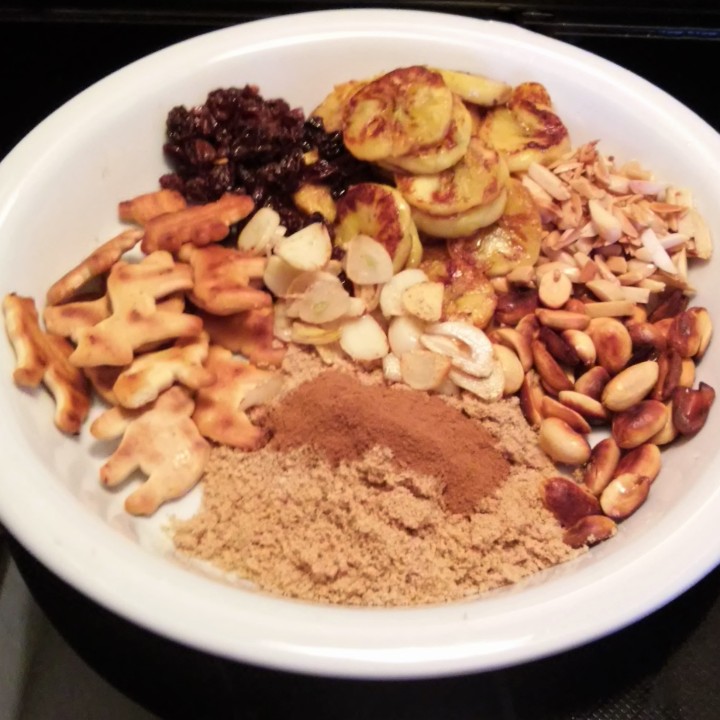
Fry the peppers in the same pan, in batches, being careful to flip frequently to avoid burning, just until they swell and turn crispy (photo below, left); place the fried peppers in a separate bowl. Once finished, deglaze the pan with a little hot water (or broth), scraping all bits from the bottom; pour the rest of the one cup of hot liquid in the pan (photo below, centre), then add to the peppers (photo below, right):
Add chocolate and 1 tsp of salt to the bowl; allow the peppers to soak for a few minutes, also letting the chocolate and salt partially dissolve, and the liquid cool down. Place all the contents of the bowl in a blender jar, then add all the ingredients from the other bowl. Process in the blender until smooth (add more water or broth if needed):
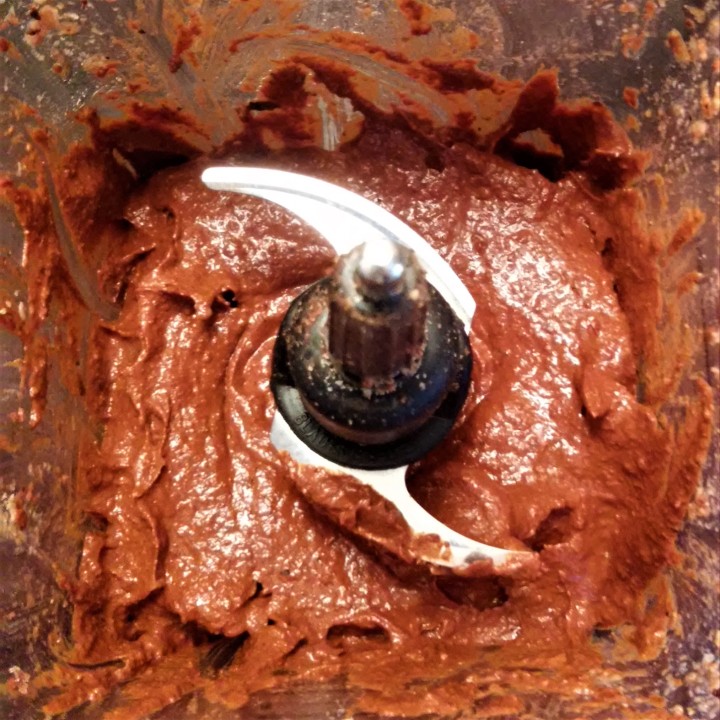
In a clean pot, warm up more oil (or lard); I used only 2 tablespoons. Pour mole and stir to avoid sticking to the bottom (photo below, left); bring to boil, then reduce heat and continue cooking and stirring. Correct seasoning with more salt, if needed; the mole turns darker as it cooks (photo below, right):
Once the mole has thickened into a paste, transfer to heat-proof containers with lids; I got about 2 cups of paste, which I labelled with the date:
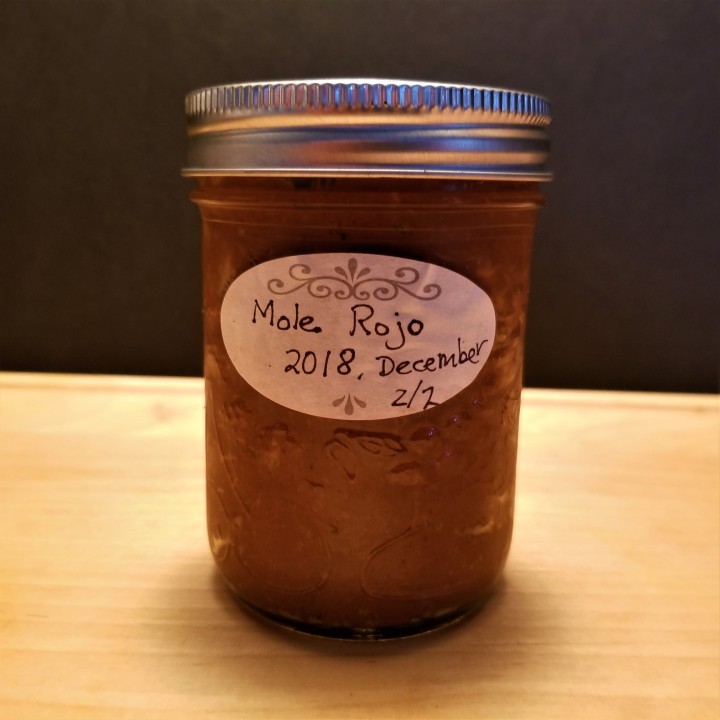
This mole paste will keep in the fridge for a couple of months. This post is getting too long, so I will continue with some comments, and instructions to prepare the mole for serving from this paste, in my next post.
I am joining Fiesta Friday #260 graciously hosted by Angie @ Fiesta Friday; this week with co-hosts Mollie @ Frugal Hausfrau (Mollie’s featured salad this week looks almost Mexican, with beets, nuts and citrus in the ingredients) and Diann @ Of Goats and Greens (Diann’s recent posts do feature Mexican food! Check out her tongue tacos and creamy green salsa).

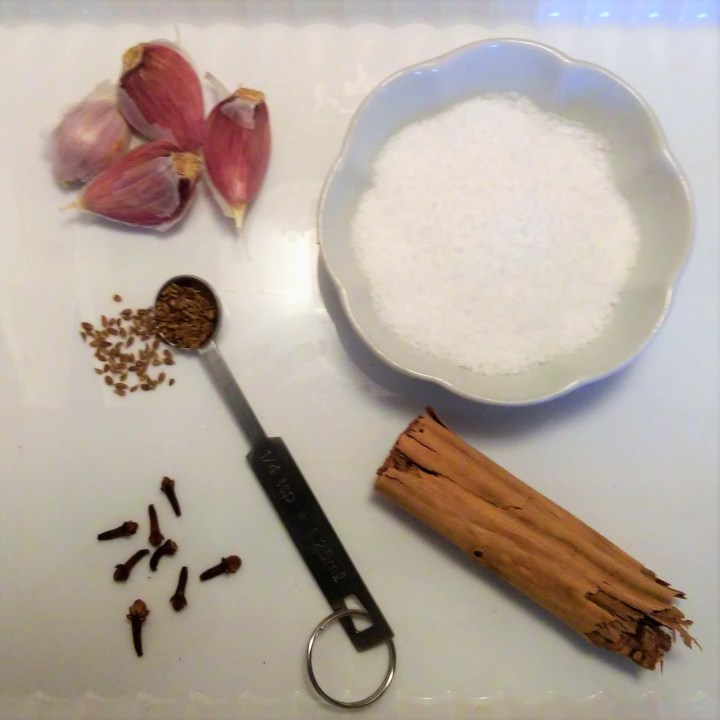
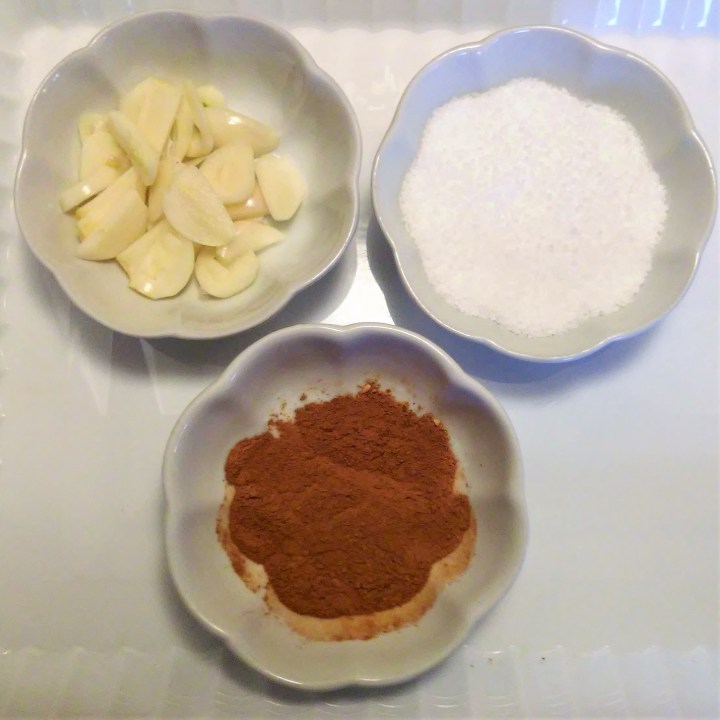
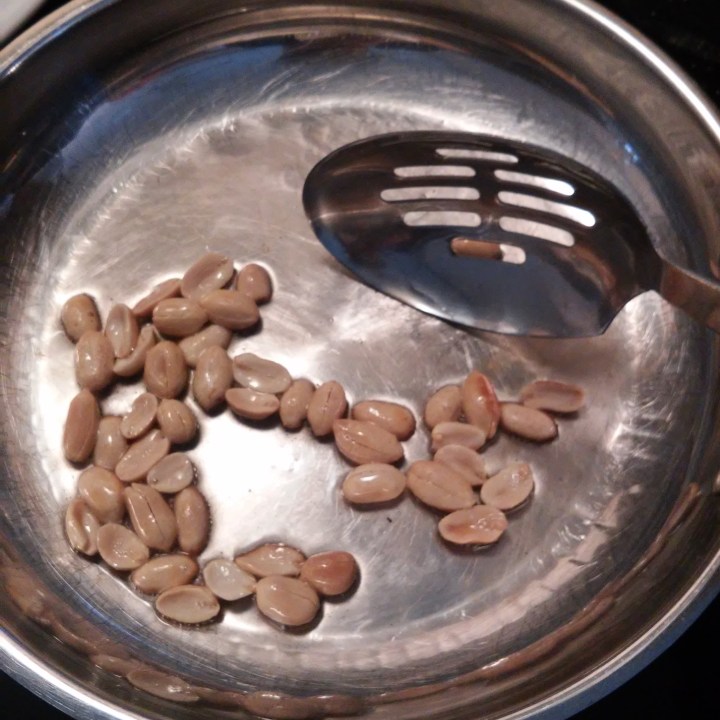

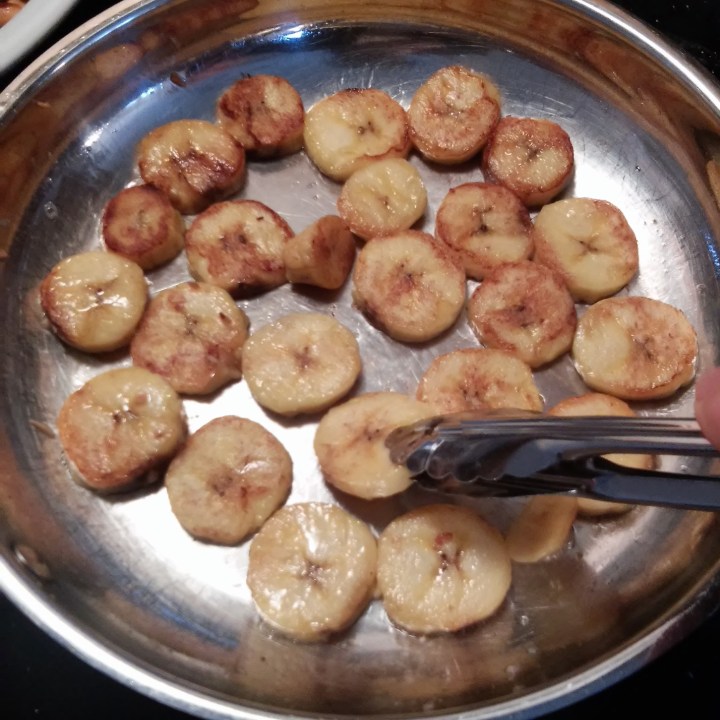
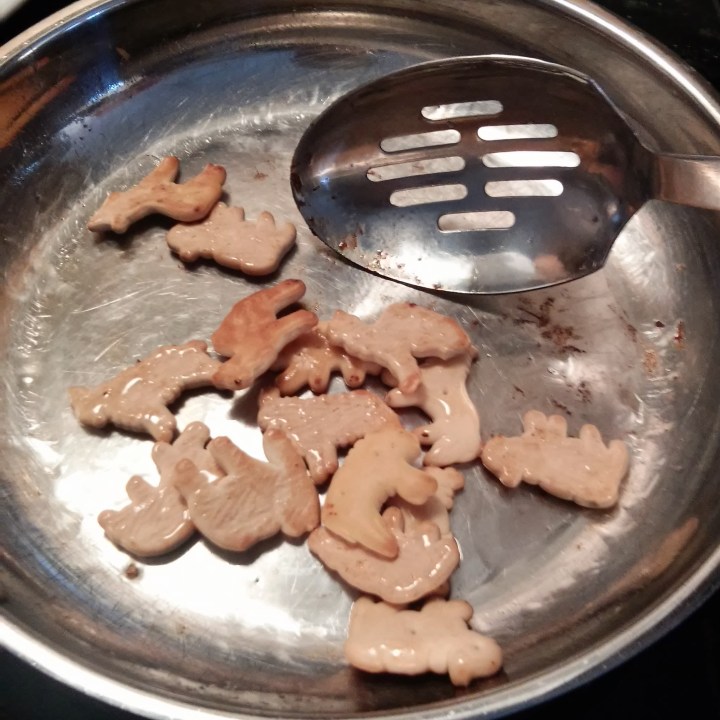
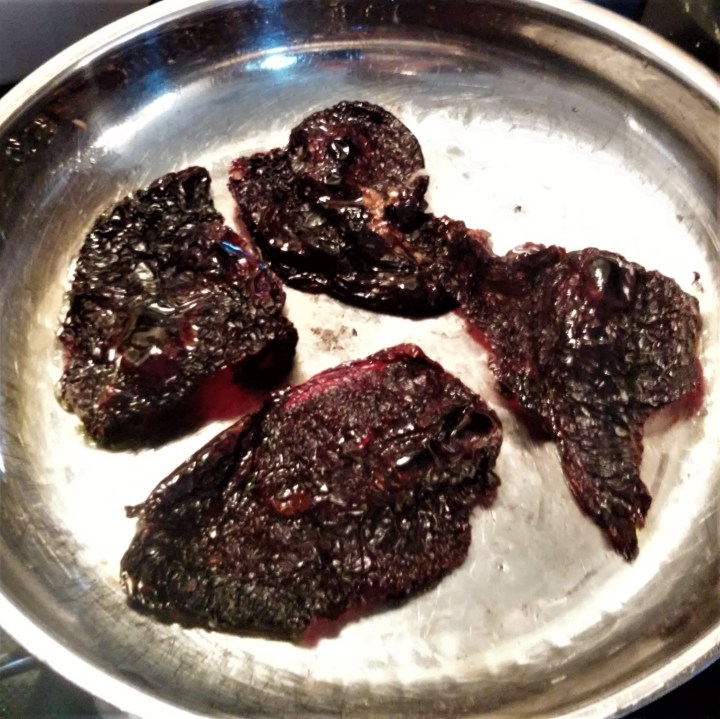
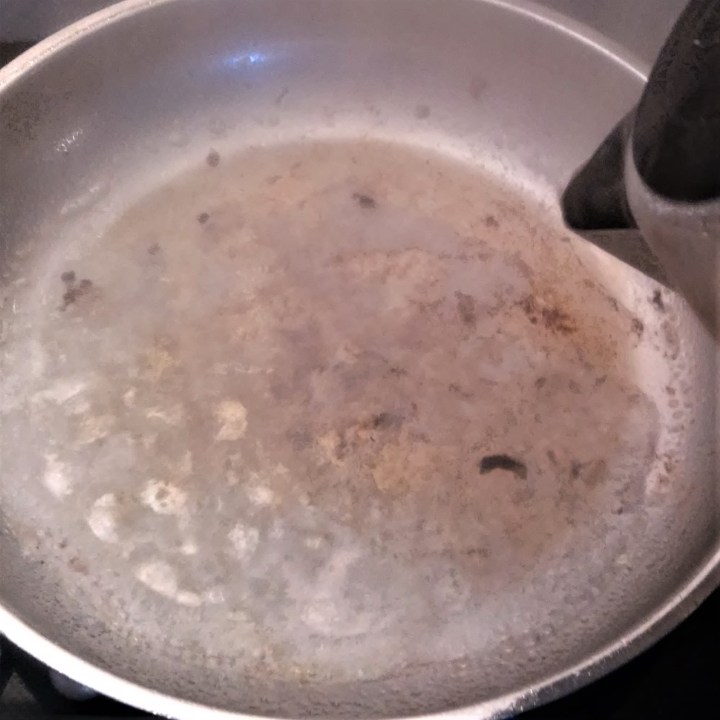
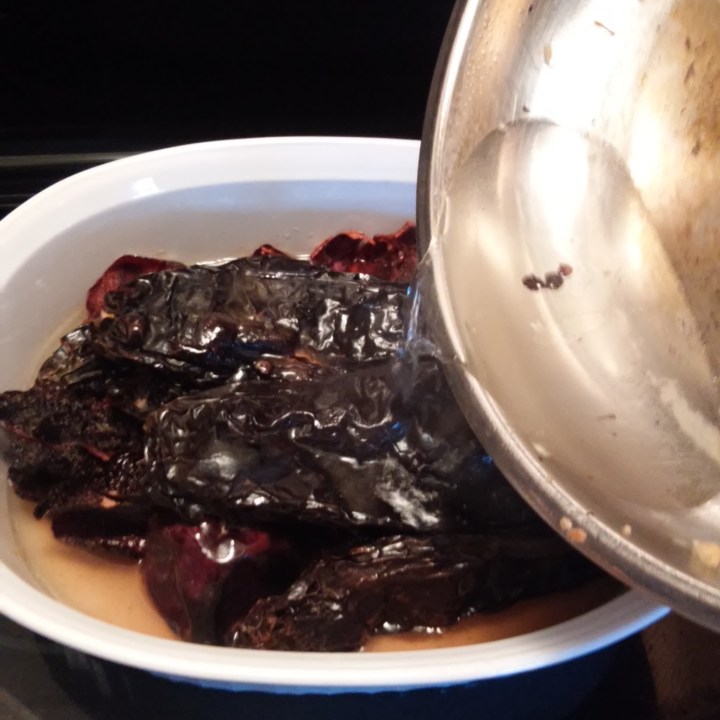
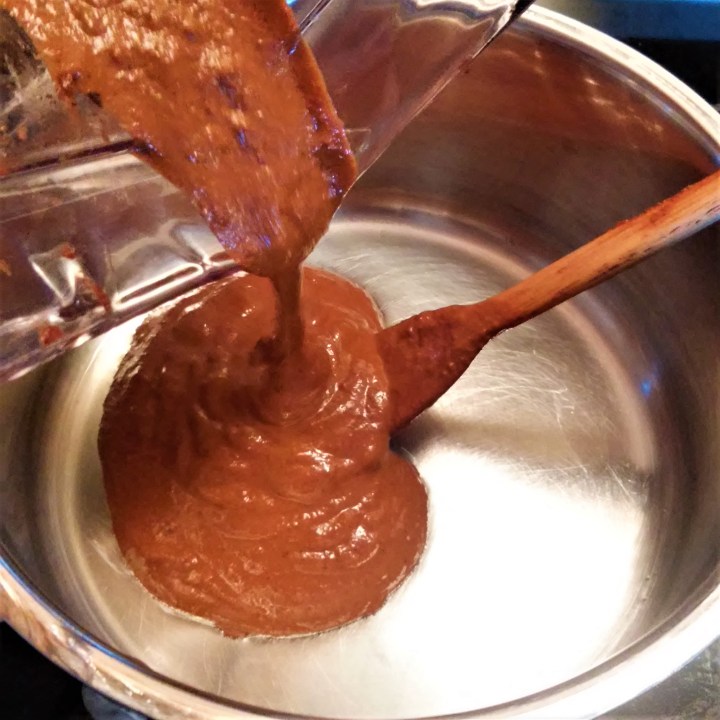
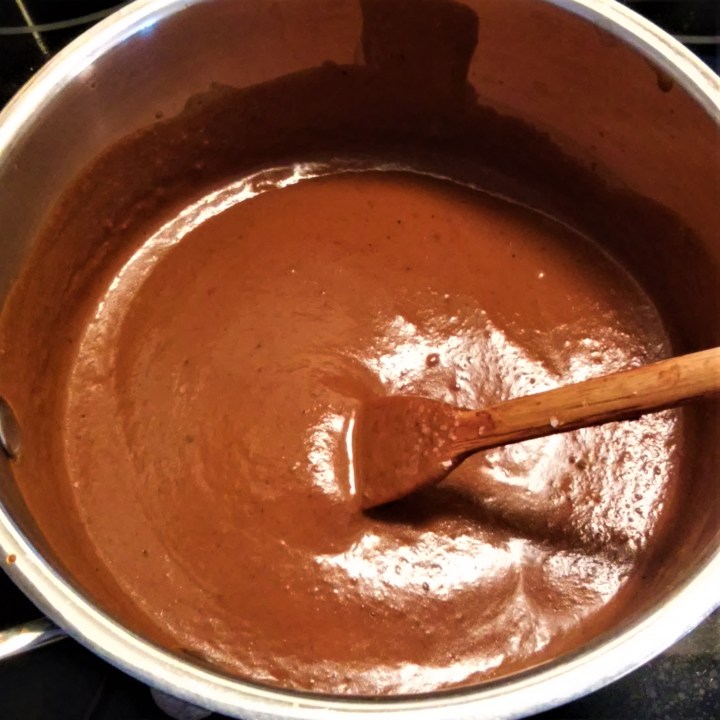







Yum, this looks complicated but wonderful!
LikeLike
It is not complicated, basically: gather, prep, fry, grind; but it is time consuming for sure. Thank you for your comment!
LikeLiked by 1 person
So happy to see this. I’ve used the mole in the jar for a long time, but to make it right will be a joy and a privilege.
LikeLike
The Dona Maria mole is really not bad, and many restaurants actually admit using it, just maybe doctored to their taste. Of course, making your own from scratch is a fun experience, I hope you like it, let me know; thank you so much for your interest, MsJadeLi!
LikeLiked by 1 person
You are welcome, Irene. Thank you for your wonderful recipes and the histories behind them.
LikeLiked by 1 person
I think I can get almost all the ingredients locally. So that’s something I think I can try out.
LikeLike
Wonderful, let me know how you liked it, if you do get a chance to try!
LikeLike
I have always used Dona Maria Mole and add my own extra ingredients. Love the recipe tho!
LikeLike
Yes, many restaurant admit to doing so; thank you for your comment, Leslie!
LikeLike
I tried mole with some rice a few months ago while volunteering with the Esperanza Peace and Justice Center. It was an interesting experience for me.The women there told me it was a popular dish to make during weddings! 🙂
LikeLike
Although modern events tend to have more cosmopolitan menus, it is still the traditional dish for weddings and any big celebration; there are expressions like “when do we get mole?” or “better start getting the mole ready” that people say to parents when their young adult children are getting serious in a relationship. 🙂
LikeLiked by 1 person
Those are cute expressions.! 🙂
LikeLiked by 1 person
I’m so excited to make this! Just printed the recipe. the animal crackers were quite a surprise!
LikeLike
I thought so, too, but the animal crackers were one of the ingredients consistently called for in the recipes I reviewed. I hope you like the recipe!
LikeLiked by 1 person
I’ve heard about mole of course, but I have never tried it. I thought it was very complicated to make, but your post makes it look doable. I guess the first step is to buy a jar to know what it tastes like. And then make my own. Thanks for another interesting post!
LikeLiked by 1 person
I think the traditional ways are complicated because they usually involve large batches (sometimes to feed hundreds of people!) as well as grinding by hand in a stone grinder. My recipe was designed for 8-10 portions, and a spice grinder and blender reduced grinding times to minutes. It is a good idea to try already made mole first to decide if you like it or not in the first place, it is a “love it or hate it” for many people. Best of luck with your mole journey!
LikeLiked by 1 person
Looks like a fascinating recipe! I like learning the history and the alternatives you mention here. I’ve discovered that almonds are indeed tree nuts I can still eat, which makes me happy.
Thanks for sharing with Fiesta Friday!
LikeLiked by 1 person
Thank you, Diann!
LikeLike
I have never had mole…. I need to try it one day. I enjoyed reading all the info!
LikeLiked by 1 person
What a great, thorough walk-through – I can halfway imagine how incredible it must smell while you’re frying all the ingredients! This looks like a fun project for an upcoming weekend.
LikeLike
You are right; preparing mole is as gratifying as eating it. Thank you for your comment!
LikeLike